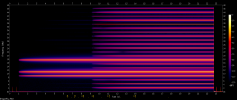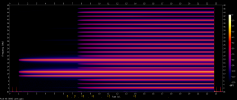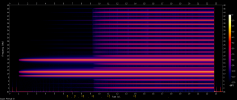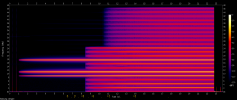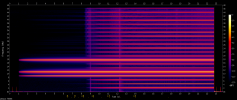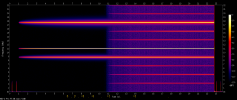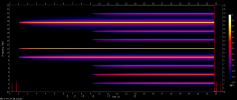In the attachment there are 44.1 kHz and 48 kHz files with Fs/4 tones which:
- start at -0.5 dBTP,
- in the last 0.1 of each second ramp up by 0.1 dB
- until they reach +2.9 dBTP.
(there are also 4 pulses at the beginning and at the end: for aligning, to "wake-up" the DAC, etc)
View attachment 323287
View attachment 323288
Below are spectrograms of outputs of a few things I have lying around:
- DragonFly Red
- Fiio K3 (USB-C) with and without gain
- Cowon Plenue D
- Samsung dongle
- Speaka (AFAIK it's a clone of DragonFly Black)
- Lenovo T480s
The 44.1 kHz file was played on Linux through ALSA using aplay command and the outputs were captured with ADI-2 Pro FS BE:
- 192 kHz sampling rate,
- ref level +13 dBu,
- different Trim Gain settings to have at least 3.5 dB of headroom when playing calibrating 220 Hz tone (3 dB for true peaks, 0.5 dB as a spare)
For spectrograms I downsampled the captured files to 96 kHz and used only the left channel, to save some vertical space. I also aligned them so that during the 10-th second the signal should be at 0 dBTP [0].
[0] For those more observant among you: yes, if the signal starts at -0.5 dBTP then it should reach 0 dBTP during the 9-th second. Well, I miscalculated a bit and in the file that I used the signal was from -0.6 dBTP to +2.8 dBTP ¯\_(ツ)_/¯
View attachment 323289View attachment 323290View attachment 323291View attachment 323292View attachment 323293View attachment 323294View attachment 323295
For ADI-2 itself I only could do a loopback recording at 44.1 kHz sampling rate. I used:
- Main out at +2 dB, ref level +4 dBu
- Phones out at 0 dB, low power setting
For phones it looks at first like it doesn't clip, so I also added spectrograms with zoomed dB scale (for both main and phones):
View attachment 323296View attachment 323297View attachment 323298View attachment 323299
And now I'll go listen to my volume-normalized music and contemplate the point of this exercise





